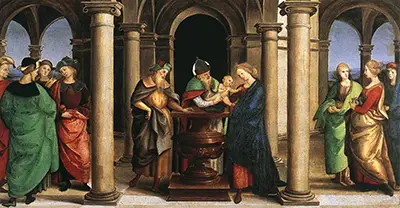 Buy Art Prints Now
Buy Art Prints Nowfrom Amazon
* As an Amazon Associate, and partner with Google Adsense and Ezoic, I earn from qualifying purchases.
The theme of humanism is well portrayed in Raphael's The Presentation in the Temple which is also known as Oddi altar-Predella. It is a theme that shows peoples’ divine responsibility in promoting human welfare.
In Raphael's The Presentation in the Temple, humanism is portrayed as the belief that man and not God has the mandate as the measure of everything. And since man has the capacity to reason, he is the one in control of his destiny. And so Raphael, the humanistic artist brings out details of the figures, drama and realism in The Presentation in the Temple.
It is still an existing drawing by Raphael that shows a tremendous extent of thought and details in which he portrays The Presentation in the Temple. It is an allegory that depicts Jesus' presentation as an infant in the Temple in Jerusalem. An initial episode of Jesus’ on earth where he was inducted into Judaism in the Temple that was at Jerusalem. It was a ceremony that combined the firstborn’s redemption and the purification.
So the theme of humanism here is given in graphic details where the faces of the priest, Mary the mother of Jesus and baby Jesus show the human side of life. Baby Jesus' attachment to the mother, yet he is part of the Holy Trinity shows the mandate of man in the promotion of humanity’s wellbeing. Raphael was an expert who realistically depicted emotion in great depth and this brought life to his paintings. The serenity of the background portrays a masterful combination of humanity and nature. But the greatest impressive scenes are the ones found in predella. A predella was a raised secondary section of an altar in an Italian painting. Raphael masterfully brought out the spacious spaces which open out underneath the Annunciation colonnades. He artistically curved out a free atmosphere of high quality in the Presentation in the Temple.
The above scenes that were painted with excellence foretold Raphael’s amazing three-dimensional insight of his future Vatican artistic compositions. The metaphoric scenes in The Presentation in the Temple were painted during Raphael’s ancient era and had a biblical theme or story. Here the Church would act as a patron while the art stood as the servant. The Presentation in the Temple and other works of Raphael’s contemporaries would act as instructors and consolers of the Christians or the faithful. And so the church through Raphael and his contemporaries’ works were used as instruments of recruiting converts to the Church. Hence, the prestigious adornment of the wall and altar. The Presentation in the Temple was symbolic and a portrayal of the reality of things. It was art for religious purposes and not art for the sake of art.
The Presentation in the Temple was a tempera painting done by a panel (board). A Tempera painting is executed with the use of pigment that is ground in a water-miscible gel to bring out the desired image. Raphael used dry pigments and binding adhesive to create this picture. Tempera was traditionally made by hand-grinding, dry-powdered colours and a diversity of plant gums. The Presentation in the Temple was commissioned by the Oddi family. It was placed at the altar of the chapel in the Church of San Francesco al Prato in Perugia, Italy. It is now housed in the Vatican Pinacoteca. In 1797, the Presentation in the Temple was taken to the Musée Napoleon in Paris and brought back to Vatican Pinacoteca in 1815.
At the onset of his painting career, Raphael was influenced by Perugino, Leonardo da Vinci and Michelangelo. And in later years, he was influenced by Donato Bramante, the very first architect called to rebuild Rome’s St Peter's Holy Basilica and thereby Raphael got to know and work with Pope Julius II. Raphael's mastery in depicting peoples’ facial expressions and positions endeared him to thousands then and millions today of art lovers. His works reveal his artistic genius and technical prowess that brought him fame in his days and even today. Even today, Raphael stands out as a balanced painter and his paintings still act as keystones of Italian Renaissance in art.




